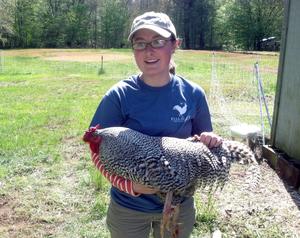
Farming is growing in popularity among recent college graduates, fed by concerns over nutrition and a weak job market.
The 24-year-old new owner of Full Heart Farm in Ledyard is one of them.
Allyson Angelini, who graduated from the UMass Sustainable Food and Farming program, last week took over the 6.25-acre property at 193 Iron St. She plans to get married on the farm in about a year.
“It doesn’t take much to fall in love with farming,” said Angelini, who gave up a desire to be a magazine journalist and instead got an agricultural education degree from the University of Massachusetts Amherst in 2009. “And farming is really cool now, and that feeling is growing.”
Erin Pirro, who supervises the Outstanding Young Farmer program in Connecticut, agreed.
“Farming is becoming sexy again,” she said. “Americans have become out of touch with their food supplies. There’s a lot of passion for locally grown food.”
Farming still has a predominately older demographic, according to the U.S. Agriculture Census. For every farmer under 35, there are six over 65, the latest census said.
Angelini’s age enabled her to be considered “disadvantaged” by the U.S. Department of Agriculture’s Farm Service Agency, making her eligible for the agency’s Beginning Farmers and Ranchers loan program.
Angelini has traveled in 5.5 years of researching farming, including working at a Stonington educational facility known as Terra Firma Farm and on a pork farm in Italy. She left her job at Jones Family Farms in Shelton in September to try to secure a farm in New London County.
Encouragement and assistance from elders is encouraging more 20-somethings to go into farming, Angelini said. Bob Burns, owner of Aiki Farms in Ledyard, was recently at Full Heart Farm, using his John Deere tractor to plow and harrow a portion of the land.
“(Angelini) is a delightful person, and Aiki Farms will support them as neighbors and fellow farmers,” said Burns, who is manager of the Ledyard Farmers Market, where Angelini plans to sell some her crops including beans, carrots, potatoes, squash and tomatoes.
Her parents, Greg and Sally Angelini, have been coming to Full Heart to help. Brother Ryan Angelini, who works at Electric Boat Corp., has also been assisting with repair projects. Keith Padin, Allyson Angelini’s fiancé, is a full partner in Full Heart, and his parents recently made their first visit to the farm.
“It’s hard to start a family farm without family around,” Allyson said.
Allyson and Keith are promoting that family feeling by giving names to each of their chickens and pigs.
Locally raised meat and produce strengthens family ties, Angelini said. And — on pure taste alone — local farming competes strongly, she said.
“Once you have farm-fresh eggs and homemade bacon, you never go back,” Angelini said.
Love of animals and land is not enough for a farmer these days, Angelini said.
“Young farmers need a wide skill set,” Angelini said. “There is so much diversity in the farm habitat.”
 Joe Swartz is the owner of the Swartz Family Farm and along with Sarah Swartz manages the Meadow Street Market (the big blue barn) in North Amherst, MA.
Joe Swartz is the owner of the Swartz Family Farm and along with Sarah Swartz manages the Meadow Street Market (the big blue barn) in North Amherst, MA.







